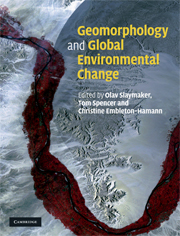Book contents
- Frontmatter
- Contents
- List of contributors
- Preface
- Acknowledgements
- List of acronyms and abbreviations
- 1 Landscape and landscape-scale processes as the unfilled niche in the global environmental change debate: an introduction
- 2 Mountains
- 3 Lakes and lake catchments
- 4 Rivers
- 5 Estuaries, coastal marshes, tidal flats and coastal dunes
- 6 Beaches, cliffs and deltas
- 7 Coral reefs
- 8 Tropical rainforests
- 9 Tropical savannas
- 10 Deserts
- 11 Mediterranean landscapes
- 12 Temperate forests and rangelands
- 13 Tundra and permafrost-dominated taiga
- 14 Ice sheets and ice caps
- 15 Landscape, landscape-scale processes and global environmental change: synthesis and new agendas for the twenty-first century
- Index
4 - Rivers
Published online by Cambridge University Press: 05 July 2015
- Frontmatter
- Contents
- List of contributors
- Preface
- Acknowledgements
- List of acronyms and abbreviations
- 1 Landscape and landscape-scale processes as the unfilled niche in the global environmental change debate: an introduction
- 2 Mountains
- 3 Lakes and lake catchments
- 4 Rivers
- 5 Estuaries, coastal marshes, tidal flats and coastal dunes
- 6 Beaches, cliffs and deltas
- 7 Coral reefs
- 8 Tropical rainforests
- 9 Tropical savannas
- 10 Deserts
- 11 Mediterranean landscapes
- 12 Temperate forests and rangelands
- 13 Tundra and permafrost-dominated taiga
- 14 Ice sheets and ice caps
- 15 Landscape, landscape-scale processes and global environmental change: synthesis and new agendas for the twenty-first century
- Index
Summary
Introduction
Water plays a key role in the transfer of mass and energy within the Earth system. Incoming solar radiation drives evaporation of about 434 000 km3 a–1 from the ocean surface and 71 000 km3 a–1 from the land surface, while precipitation delivers about 398 000 km3 a–1 of water to the ocean and 107 000 km3 a–1 to the land surface. The balance is redressed through the flow of 36 000 km3 a–1 of water from the land to the oceans via rivers (data in Berner and Berner, 1996). Environmental change affecting any of these water transfers produces changes in runoff and river flows, hence in the rivers themselves.
Changing climate is intensifying the global hydrological cycle, leading to significant changes in precipitation, runoff and evapotranspiration (Huntington, 2006; Bates et al., 2008; see also Chapter 1). Intensification of the hydrological cycle is likely to mean an increase in hydrological extremes (IPCC, 2001). Changes in the frequency distribution of precipitation alter water flows and water availability in the surface environment leading, in turn, to a change in river regimes.
These factors are superimposed upon the effects of human actions associated with land use and with the attempt to control water for various uses that have directly changed river channels and the quality of water flowing in them. Land surface condition mediates quantity of water and the amount and calibre of sediment delivered to rivers which, in turn, influences river sedimentation, morphology and stability. Humans also manipulate the terrestrial hydrological cycle deliberately by construction of reservoirs, abstractions of water for human use, and discharges of water into river courses. Moreover, we directly modify watercourses by realigning them, by river ‘training’ works, by dredging, by fixing banks and building dykes.
- Type
- Chapter
- Information
- Geomorphology and Global Environmental Change , pp. 98 - 129Publisher: Cambridge University PressPrint publication year: 2009
- 4
- Cited by



